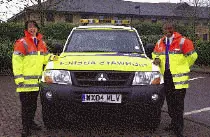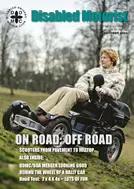Lawrence Vos, of the Highways Agency, looks at another pilot project in the West Midlands aiming to make driving easier and safer.
If you have had the misfortune of breaking down on one of England's
motorways, regardless of your ability, you know the distress it can cause, but
for motorists in the West Midlands extra help is on hand. The Highways Agency Traffic Officer service is now more than six months into operation in the West Midlands, helping to reduce congestion, and freeing up the police to deal with criminal activities on the network.
Traffic Officers are on the road to help you if you are stranded on the hardshoulder.
They will offer valuable safety advice, secure the area you are located in and even call your recovery organisation to arrange your safe removal from the
roadside.
With preparations in place to deliver the Traffic Officer service across
England, 2004 has witnessed not only the birth of the service in April, but also
the passing of the Traffic Management Bill in July, giving Traffic Officers new
powers on the motorway network.
The Highways Agency Traffic Officer service began life in April this year to keep traffic moving and ease congestion, and at the same time to help the police by taking on board the management of minor incidents, such as breakdowns and debris clearance.
Eight patrols currently operate in the West Midlands, and this is set to increase
to 14 by the end of the year. With just under 100 staff at present, working both
on the road and in the Regional Control Centre control room, numbers will
soon be expanding to meet the growing demand of you the road user.
Working alongside an amalgamation of traffic police services in the West
Midlands region, the Highways Agency Traffic Officers have been learning the
skills required to operate in a highly dangerous environment.
Traffic Management Act With the announcement in July that the Traffic Management Act gained Royal Assent, the role and responsibilities of Traffic Officers immediately increased, giving the service powers previously only the police had. While Highways Agency Traffic Officers will not have the powers to arrest or fine, the Act will give them the powers to stop traffic, close roads, lanes and carriageways, direct and divert traffic and both place and operate
traffic signs.
Traffic Officers now have the powers to stop and direct motorists, cyclists
and pedestrians on the motorway when managing traffic on that motorway and
if an official traffic survey is being carried out. Furthermore, refusal to divulge name and address details if and when requested by a traffic officer is also
offence. These offences could lead to a fine, or in extreme cases a prison sentence.
Recognising a Traffic Officer 
As a relatively new service not everyone will have encountered a traffic officer
while travelling on the West Midlands motorway network, but with highly visible
vehicles and highly visible uniforms they are easy to recognise.
Driving either Range Rover or Mitsubishi Shogun vehicles, the traffic officer patrols are visible in the form of a chequered design made from black and
luminous yellow vinyl material on the doors and side panels, and alternative
orange and yellow diagonal stripes also made from the same material on the rear. 
The vehicle bonnet design is made from fluorescent yellow vinyl featuring a blue swoosh across the top and the words Highways Agency in blue in reverse, and in order to be recognisable from the air the vehicles contain the letters HA and a recognisable three-digit number on the roof.
Inside each vehicle are more than 65 pieces of equipment used to help clear
debris from the road and provide assistance to Traffic Officers managing roadside incidents, including 20 cones, traffic signs to communicate changes in road conditions to drivers and a dog catching pole – stray animals can be a common and dangerous occurrence.
Managing this equipment and ensuring it is used in the correct way are the
Traffic Officers themselves, who like the vehicles, will be highly visible when out
on patrol. Aside from their vehicle and Highways Agency identification card,
Traffic Officers can be identified through their distinctive yellow luminous jackets with orange insert, featuring the HA logo.
Traffic Officers are on patrol in the West Midlands helping broken down
motorists, offering safety advice and arranging recovery with your recovery
organisation if required.
They are additional sets of eyes and ears on the motorway, here to help make
sure you have a safe and reliable journey.
The future
Across the motorway network the traffic officer service will see up to 1,200 staff on-road and 300 staff in seven regional control centres. They will eventually be working around the clock to manage minor incidents, and support the police and other emergency services in major incidents.
The service will be rolled out across the country in 2005, with the South East
and North West regions going live in by the Summer and East, North East, South West and East Midlands by the end of next year.
See the HIghways Agency website www.highways.gov.uk 
|

